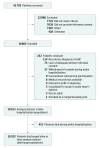Global Differences in Characteristics, Precipitants, and Initial Management of Patients Presenting With Acute Heart Failure
- PMID: 31913404
- PMCID: PMC6990673
- DOI: 10.1001/jamacardio.2019.5108
Global Differences in Characteristics, Precipitants, and Initial Management of Patients Presenting With Acute Heart Failure
Abstract
Importance: Acute heart failure (AHF) precipitates millions of hospital admissions worldwide, but previous registries have been country or region specific.
Objective: To conduct a prospective contemporaneous comparison of AHF presentations, etiologic factors and precipitants, treatments, and in-hospital outcomes among global regions through the International Registry to Assess Medical Practice with Longitudinal Observation for Treatment of Heart Failure (REPORT-HF).
Design, setting, and participants: A total of 18 553 adults were enrolled during a hospitalization for AHF. Patients were recruited from the acute setting in Western Europe (WE), Eastern Europe (EE), Eastern Mediterranean and Africa (EMA), Southeast Asia (SEA), Western Pacific (WP), North America (NA), and Central and South America (CSA). Patients with AHF were approached for consent and excluded only if there was recent participation in a clinical trial. Patients were enrolled from July 23, 2014, to March 24, 2017. Statistical analysis was conducted from April 18 to June 29, 2018; revised analyses occurred between August 6 and 29, 2019.
Main outcomes and measures: Heart failure etiologic factors and precipitants, treatments, and in-hospital outcomes among global regions.
Results: A total of 18 553 patients were enrolled at 358 sites in 44 countries. The median age was 67.0 years (interquartile range [IQR], 57-77), 11 372 were men (61.3%), 9656 were white (52.0%), 5738 were Asian (30.9%), and 867 were black (4.7%). A history of HF was present in more than 50% of the patients and 40% were known to have a prior left-ventricular ejection fraction lower than 40%. Ischemia was a common AHF precipitant in SEA (596 of 2329 [25.6%]), WP (572 of 3354 [17.1%]), and EMA (364 of 2241 [16.2%]), whereas nonadherence to diet and medications was most common in NA (306 of 1592 [19.2%]). Median time to the first intravenous therapy was 3.0 (IQR, 1.4-5.6) hours in NA; no other region had a median time above 1.2 hours (P < .001). This treatment delay remained after adjusting for severity of illness (P < .001). Intravenous loop diuretics were the most common medication administered in the first 6 hours of AHF management across all regions (65.4%-89.9%). Despite similar initial blood pressure across all regions, inotropic agents were used approximately 3 times more often in SEA, WP, and EE (11.3%-13.5%) compared with NA and WE (3.1%-4.3%) (P < .001). Older age (odds ratio [OR], 1.0; 95% CI, 1.00-1.02), HF etiology (ischemia: OR, 1.65; 95% CI, 1.11-2.44; valvular: OR, 2.10; 95% CI, 1.36-3.25), creatinine level greater than 2.75 mg/dL (OR, 1.85; 95% CI, 0.71-2.40), and chest radiograph signs of congestion (OR, 2.03; 95% CI, 1.39-2.97) were all associated with increased in-hospital mortality. Similarly, younger age (OR, -0.04; 95% CI, -0.05 to -0.02), HF etiology (ischemia: OR, 0.77; 95% CI, 0.26-1.29; valvular: OR, 2.01; 95% CI, 1.38-2.65), creatinine level greater than 2.75 mg/dL (OR, 1.16; 95% CI, 0.31-2.00), and chest radiograph signs of congestion (OR, 1.02; 95% CI, 0.57-1.47) were all associated with increased in-hospital LOS.
Conclusions and relevance: Data from REPORT-HF suggest that patients are similar across regions in many respects, but important differences in timing and type of treatment exist, identifying region-specific gaps in medical management that may be associated with patient outcomes.
Conflict of interest statement
Figures



References
-
- Ponikowski P, Voors AA, Anker SD, et al. ; ESC Scientific Document Group . 2016 ESC Guidelines for the diagnosis and treatment of acute and chronic heart failure: the Task Force for the diagnosis and treatment of acute and chronic heart failure of the European Society of Cardiology (ESC)Developed with the special contribution of the Heart Failure Association (HFA) of the ESC. Eur Heart J. 2016;37(27):2129-2200. doi: 10.1093/eurheartj/ehw128 - DOI - PubMed
-
- Maggioni AP, Dahlström U, Filippatos G, et al. ; Heart Failure Association of the European Society of Cardiology (HFA) . EURObservational Research Programme: regional differences and 1-year follow-up results of the Heart Failure Pilot Survey (ESC-HF Pilot). Eur J Heart Fail. 2013;15(7):808-817. doi: 10.1093/eurjhf/hft050 - DOI - PubMed
-
- Adams KF Jr, Fonarow GC, Emerman CL, et al. ; ADHERE Scientific Advisory Committee and Investigators . Characteristics and outcomes of patients hospitalized for heart failure in the United States: rationale, design, and preliminary observations from the first 100,000 cases in the Acute Decompensated Heart Failure National Registry (ADHERE). Am Heart J. 2005;149(2):209-216. doi: 10.1016/j.ahj.2004.08.005 - DOI - PubMed
-
- Cleland JG, Swedberg K, Follath F, et al. ; Study Group on Diagnosis of the Working Group on Heart Failure of the European Society of Cardiology . The EuroHeart Failure Survey Programme—a survey on the quality of care among patients with heart failure in Europe; part 1: patient characteristics and diagnosis. Eur Heart J. 2003;24(5):442-463. doi: 10.1016/S0195-668X(02)00823-0 - DOI - PubMed
Publication types
MeSH terms
LinkOut - more resources
Full Text Sources
Medical
Research Materials
Miscellaneous

